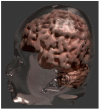16p11.2 Microduplication Syndrome with Increased Fluid in the Cisterna: Coincidence or Phenotype Extension?
- PMID: 37628634
- PMCID: PMC10454344
- DOI: 10.3390/genes14081583
16p11.2 Microduplication Syndrome with Increased Fluid in the Cisterna: Coincidence or Phenotype Extension?
Abstract
We report the first case of a child with 16p11.2 microduplication syndrome with increased fluid in the cisterna magna seen on magnetic resonance imaging (MRI). This finding may correspond to a Blake's Pouch Cyst (BPC) or a Mega Cisterna Magna (MCM), being impossible to differentiate through image examination. The molecular duplication was diagnosed using chromosomal microarray analysis with single nucleotide polymorphism (SNP). We review the clinical and neuroimaging features in published case reports in order to observe the findings described in the literature so far and present a skull three-dimensional model to contribute to a better understanding. Despite the variable expressivity of the syndrome being well known, there is no case described in the available literature that mentions the association of 16p11.2 microduplication and the presence of BPC or MCM seen in neuroimaging exams. This finding may represent an extension of the phenotype not yet reported or may present itself as a coincidence in a child with various malformations.
Keywords: 16p11.2 microduplication syndrome; Blake’s pouch cyst; Mega cisterna magna.
Conflict of interest statement
The authors have no conflict of interest to disclose.
Figures






References
-
- Hamosh A. Chromosome 16p11.2 Duplication Syndrome. OMIM. Jan, 2020. [(accessed on 1 June 2023)]. Available online: https://www.omim.org/
-
- Proximal 16p11.2 Microduplication Syndrome. Orphanet, ORPHA. 370079. Jul, 2023. [(accessed on 22 July 2023)]. Available online: https://www.orpha.net/consor/cgi-bin/OC_Exp.php?lng=EN&Expert=370079.
-
- Fernandez F.B.A., Roberts W., Chung B., Weksberg R., Meyn S., Szatmari P., Joseph-George A.M., MacKayKathy S., Noble W.B. Phenotypic spectrum associated with de novo and inherited deletions and duplications at 16p11.2 in individuals ascertained for diagnosis of autism spectrum disorder. J. Med. Genet. 2010;47:195–203. doi: 10.1136/jmg.2009.069369. - DOI - PubMed
Publication types
MeSH terms
LinkOut - more resources
Full Text Sources
Molecular Biology Databases

